Head to head: which is the fastest aero helmet?
We put four aero helmets to the velodrome to test their performance

Advancing technology means that aero road helmets have become pretty commonplace – they’re well ventilated and comfortable enough that few riders think twice about adopting one as a mainstay lid.
>>> Best cycling helmets reviewed
Reducing your aerodynamic drag via a streamlined helmet makes sense. You, as a rider are 80 per cent of drag, and the largest proportion of that comes from your frontal area, including your head and shoulders.
Each new aero helmet launch is accompanied by independent aero claims around its wattage saving credentials. However, your equipment is only part of the equation – how the airflow interacts with the helmet will be impacted by your own shape and body position.
To determine how big – or small – the differences are, we checked in with Aerocoach’s Xavier Disley to test four aero helmets against one baseline lid, on two different riders.
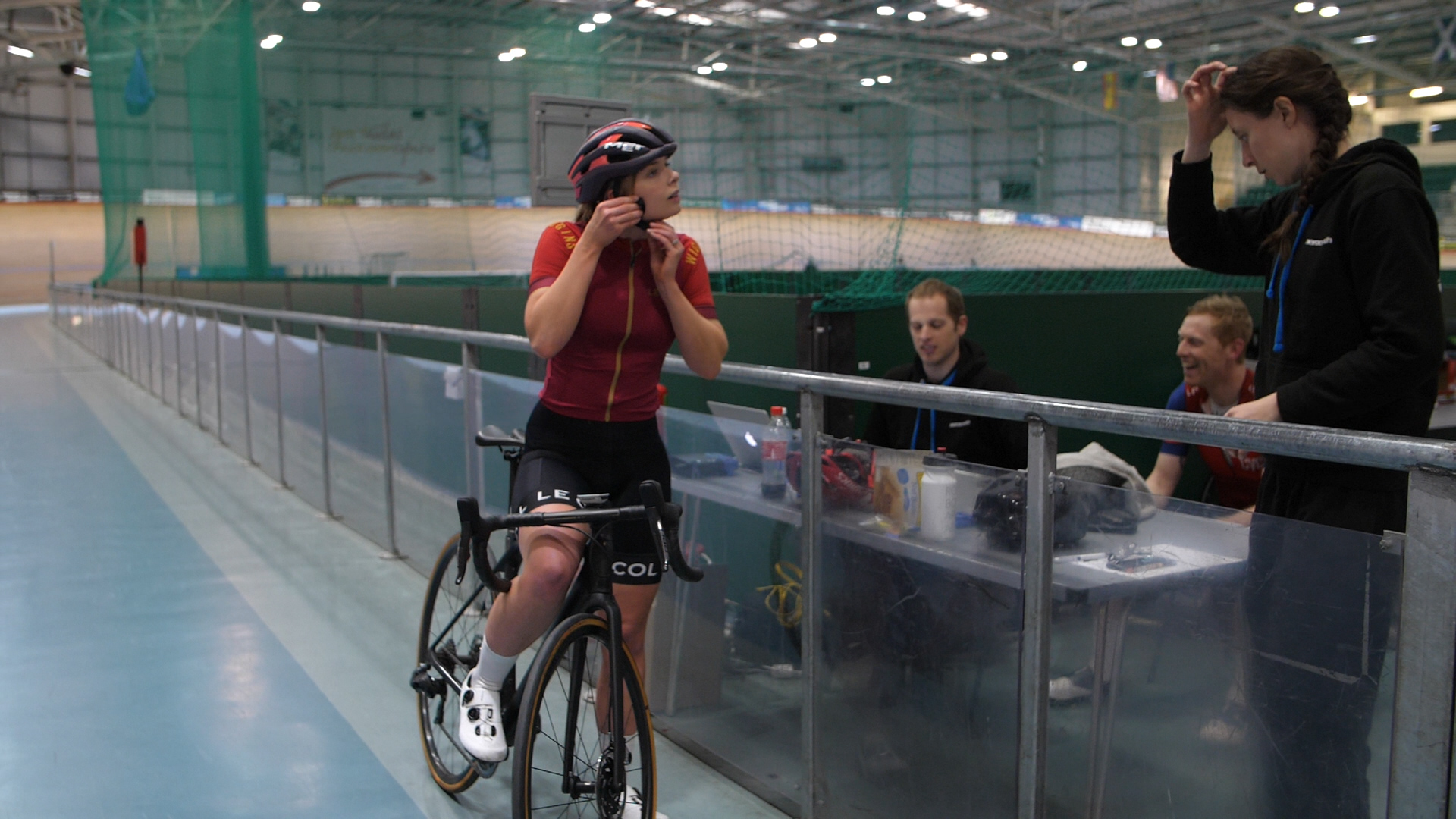
Rider one – James - measures in at 183 centimetres in height, with 48cm wide shoulders, whilst rider two – Michelle - is 165cm tall with 37cm shoulders.
Our data did show differences between the performances of the helmets between the two riders. However, helpfully for readers at home who don’t have access to these facilities, there was also one very clear winner.
The latest race content, interviews, features, reviews and expert buying guides, direct to your inbox!
It is however worth bearing in mind that the differences between the helmets’ aerodynamic performance were marginal, especially at slower speeds. At 30kph, the variance between the best and worst helmets was two-three watts depending upon the tester; many riders may be happy to give this away in favour of choosing the helmet that’s most comfortable. Sped up to 45kph, the differences jumped to nine to 10 watts which is a more significant gain.
Testing process
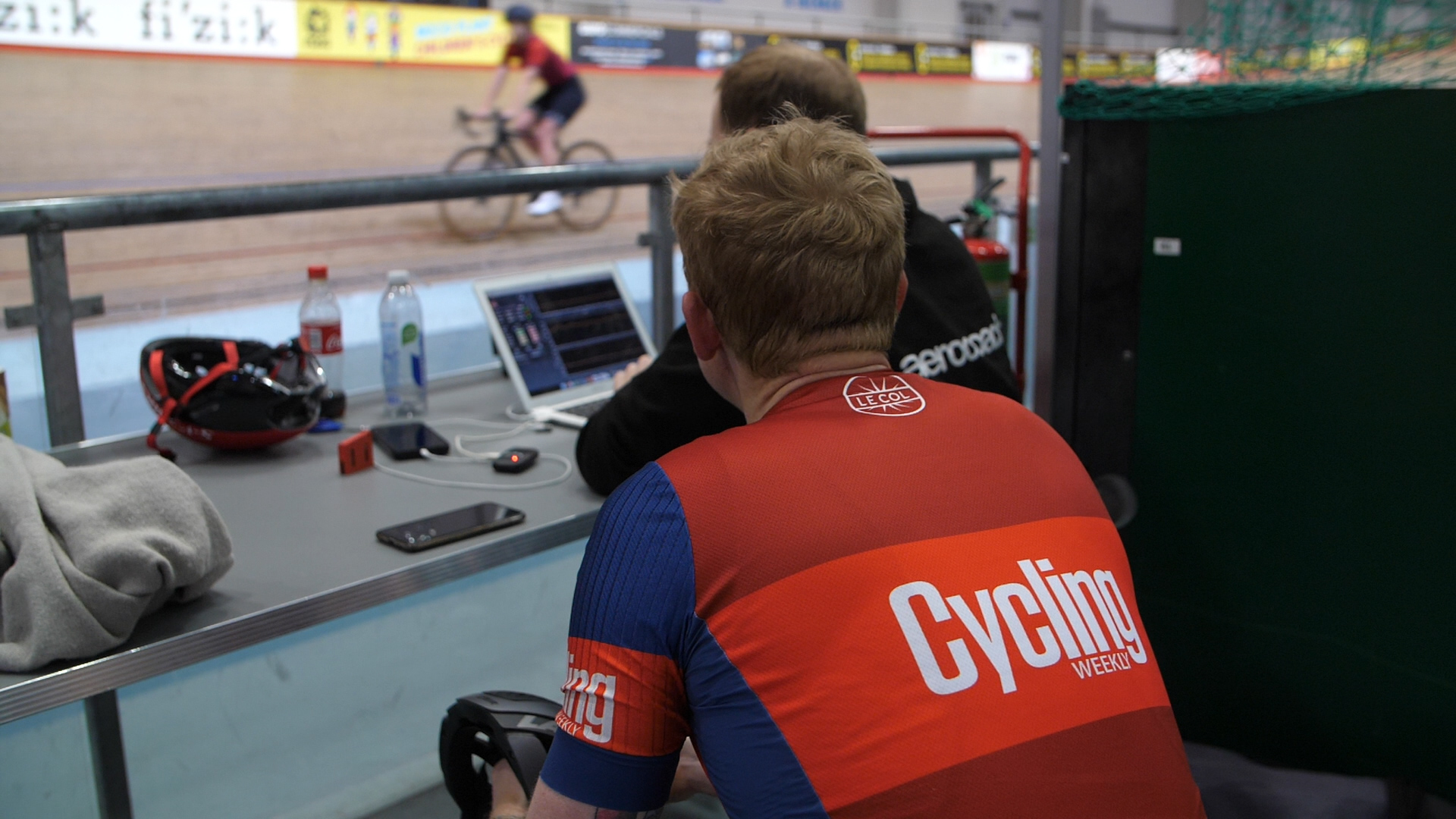
The helmets on test were the Specialized Evade, Lazer Bullet, Giro Vanquish and Bontrager Bullet. Our baseline helmet was Met’s Trenta - this is designed to be an aero but breathable middle ground, and is less optimised than Met’s dedicated aero lid the Met Manta.
The Trenta is certainly no slouch. Indeed it turned out to be pretty fast – but it still serves as an effective baseline and all wattage savings (or otherwise) listed are a comparison to the initial run in the Trenta, with hands on the tops.
We carried out the test runs at Newport Velodrome, a favourite haunt for Disley.
>>> Can you aero test at home?
“We do testing using the Garmin Track Aero system. This is made up of hardware and software that allows us to track your coefficient of drag (CdA) every single second as you ride round the track,” he explained.
During the testing, we ran control repeats to account for changes within the velodrome, and to ensure riders were holding a consistent position.
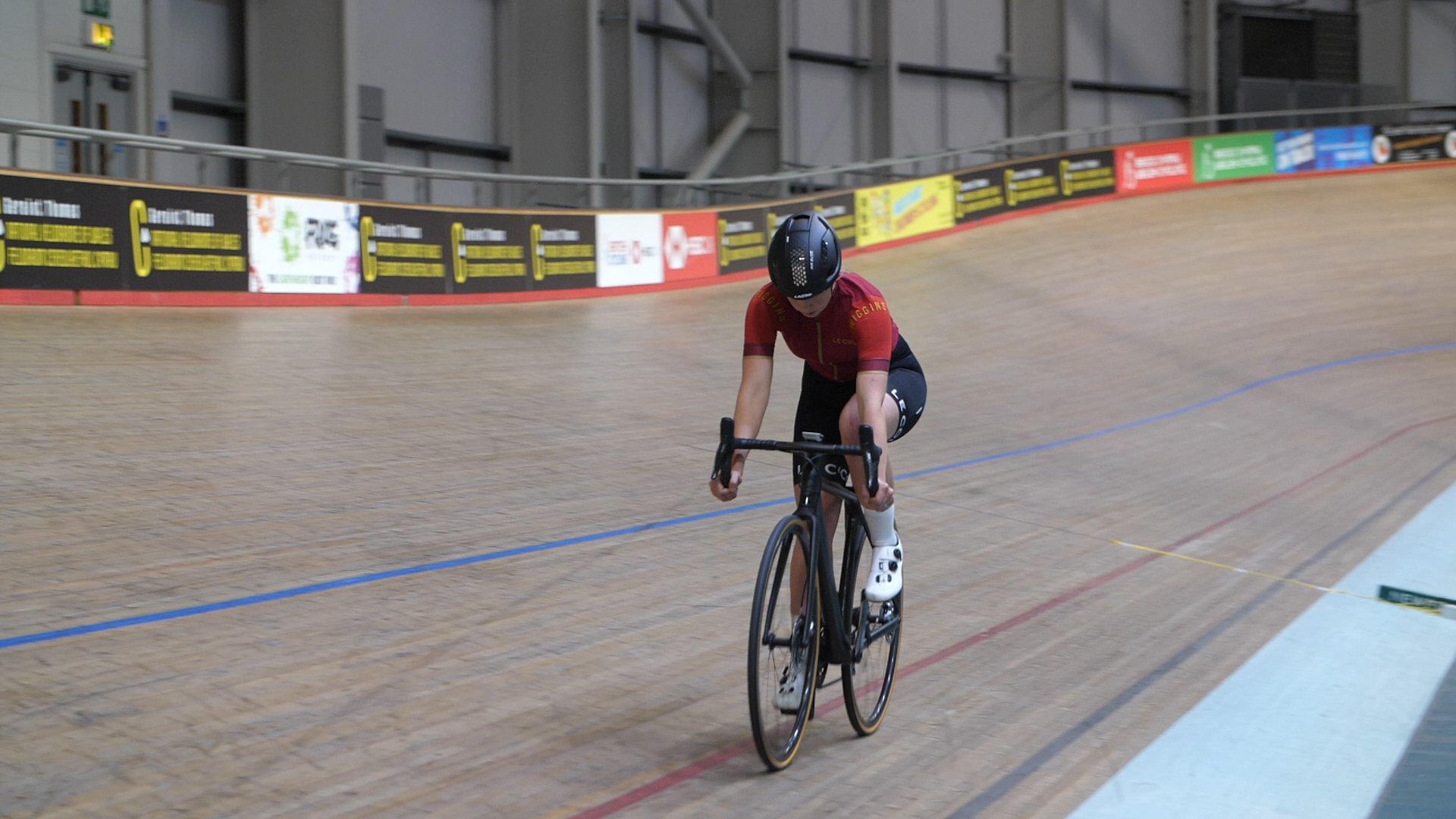
In order to increase rider consistency, we used two defined positions – riding on the tops and drops, with straight arms in both cases.
“Locking out your arms means its more consistent, a slightly bent arm is less so because you may bend it more or less between runs,” Disley says.
On the tops, we experimented with turning our heads to the side each lap, to simulate a rider who is moving around a lot on the bike, then on the drops we tried both a neutral and dropped head position, simulating fatigue or a sprint.
We’ve listed wattage savings at 30 kilometres per hour, and 45kph.
“Wattage savings at 45kph are going to higher than those at 30kph. However, these numbers are based on still conditions. If you’re travelling at 30kph but into a banging headwind, the relative air speed is higher, so being more aerodynamic is important and it start to look like you’re travelling at 45kph in still air,” explains Disley.
The helmet line up
Specialized Evade II MIPS
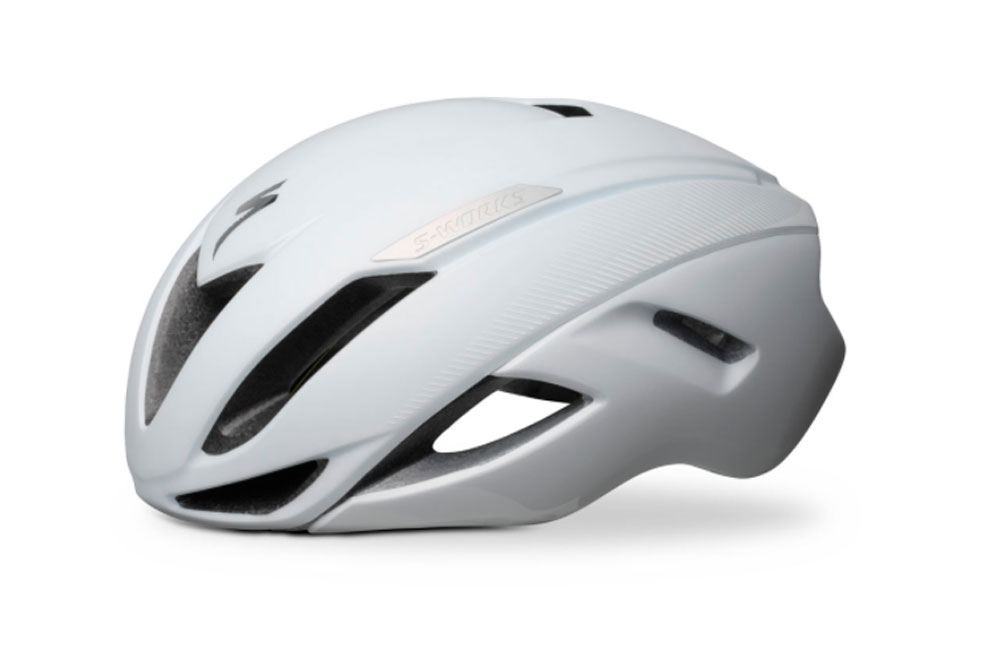
Weight 261g (Small)
Score, following aero testing: 10/10
Price: £230
Read more: Specialized S-Works Evade II review
Aero performance: First of four for both testers
The Evade is a longstanding member of the Specialized helmet line-up, and it has received several makeovers. The last major overhaul was in 2018, and since then the brand has added a MIPS layer, as well.
Specialized says that the most recent version of the Evade is six seconds faster over 40kph versus the outgoing model. It’s also got an improved ventilation system, with 12 vents in total, that’s a big increase on the outgoing model, though each vent is smaller in size.
Both our testers found the Evade to be extremely comfortable. It’s also very breathable, and didn’t even leave Michelle hot headed after a week riding in the mountains around Denia/Calpe, Spain.
When it comes to safety, as well as the added MIPS layer, the Evade II has a patented energy optimised multi-density EPS construction and an aramid-reinforced skeleton designed to protect your head in the event of an accident. You also get the ‘ANGI’ add on, which when activated via an external app can alert loved ones if you do have a crash.
There’s a ‘Gutter Action Brow Pad’ to channel sweat away from your eyes, plus a micro dial at the back and the brand’s famous ‘Mindset HairPort II’. The dial is easy to operate, even when wearing gloves and our long haired tester found the fit worked well with a ponytail.
When it comes to closure, the brand uses a magnetic clasp below the chin. This feels premium, but we do wonder over its safety in a crash.
Though not the best in every single circumstance, when we average out the four positions tested, the Evade was a clear winner for both riders. It was the fastest for James in the drops, and in the drops with his head lower, whilst for Michelle it was fastest overall when riding on the tops.
Lazer Bullet 2.0
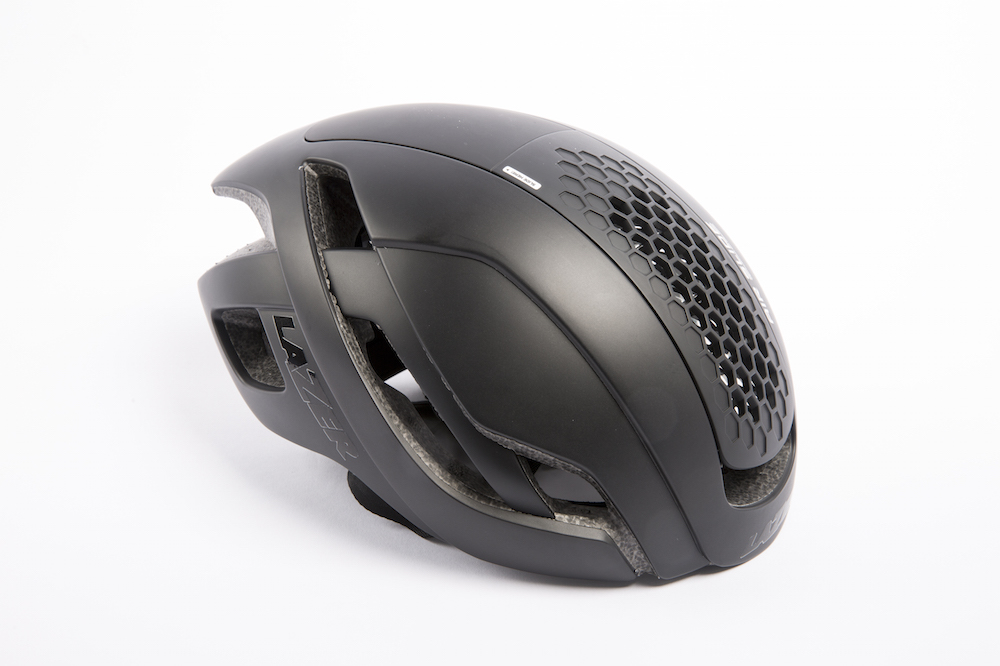
Weight 367g (Medium)
Score, following aero testing: 7/10
Price: £219.99 (£239.99 MIPS version)
Read more: Lazer Bullet helmet review
Aero performance: Fourth of four for Michelle, second of four for James
The Lazer Bullet is a feature packed lid. It comes with an 'Airslide' honeycomb vent, which can be ridden open or closed - the latter allowing for greater airflow. There's also an add-on in the box, in the shape of a solid replacement for the honeycomb insert.
The closed-off, solid option is advertised as being designed in collaboration with the Lotto Soudal “primarily to provide an edge in sprint finishes” – since most amateur riders are likely to place an importance on breathability over competition in WorldTour sprints, we tested the helmet at the middle ground – with the honeycomb vent fitted, but closed.
As with the Giro Vanquish, the Bullet also comes with a specific visor to be used with the helmet, which would improve it's aero qualities even further for the rider wanting to use the helmet for a TT. However, in order to keep the comparison with other helmets as fair as possible we opted not to use it during testing.
A small frontal area and teardrop profile aim to improve the aerodynamics. Adjustment is operated via a rear dial, and there's a rear light fitted to the back for a little additional safety.
The Bullet proved to be the heaviest of the helmets on test, probably down to the additional features included so both testers were more aware of the helmet during testing.
The Bullet 2.0 is the only helmet on test not to feature a MIPS or similar safety feature as standard, though this is available at £239.99.
The back of the helmet is quite closed off by the retention cradle, which didn't allow our long-haired tester to feed a ponytail (or aero plait) through, and the wings of the cradle also dug in a little bit.
Disley believes the helmet would perform better with the solid cover in place, commenting: "Our recommendation would not be to use the vents closed, because it didn't come out very fast. I reckon if we did re-do the test, using the smooth cover, or even with the vents open, it would perform differently certainly and I would expect slightly better."
Giro Vanquish MIPS
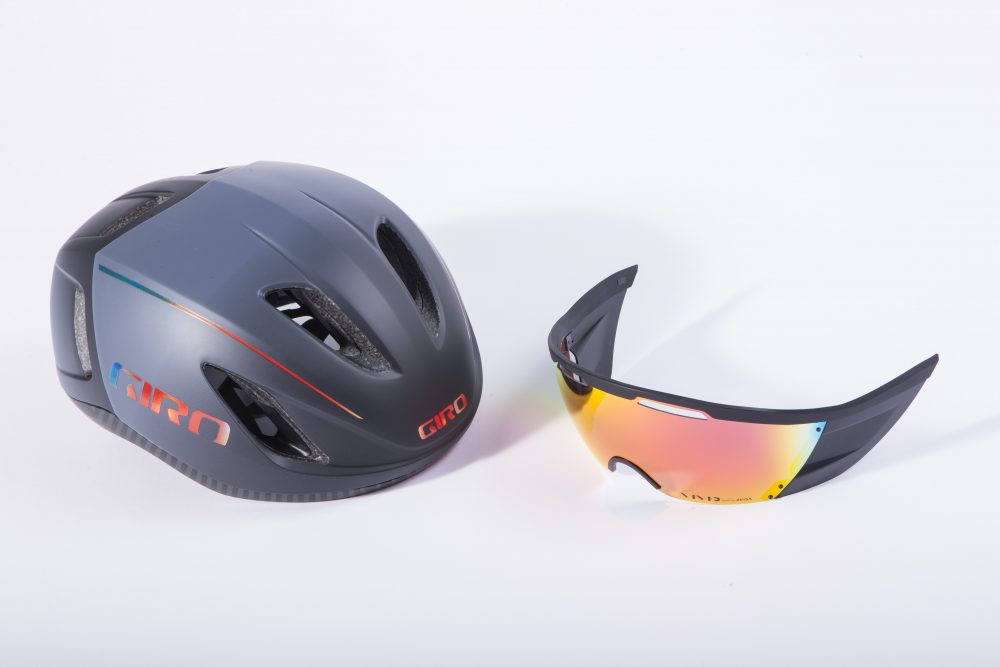
Weight 300g (medium)
Score, following aero testing: 7/10
Price: £220
Read more: Giro Vanquish MIPS helmet review
Aero performance: Third of four for Michelle, fourth of four for James
The Vanquish has been worn by some prestigious riders, including Mark Cavendish, and it’s been designed following wind tunnel testing and extensive computational fluid dynamics analysis.
It aims to be a compromise between a typical road helmet and a specific, aerodynamic TT style helmet. You can choose to ride it with or without the visor. Since we imagine most people aiming to train or compete in road races will opt for without, we tested it in this configuration.
The Giro Vanquish’s outer shell has been almost split in two with the largely featureless front portion designed to look like it wraps over the smaller and narrower rear half. This wrap is something Giro call TransformAir and the step down acts to trick air into behaving as if the helmet has a traditional tear drop TT shape but allows for a more practical shell design.
Four forward facing vents are employed to do the job of pulling cooler air over your head and these are complimented by six further vents at the rear designed to dispel warm air and regulate head temperature. We found these to be very efficient, it’s nowhere near as airy as a pure road helmet but you can feel the vents doing their job and the internal channelling works very well to release warm air and sweat.
Inside and Giro has employed the latest MIPS safety liner, and the liner is made of a much more breathable material than previous versions and has no noticeable negative impacts on the fit or comfort of the Vanquish. It also incorporates Giro’s longstanding Roc Loc retention system and anti-microbial pads to create an environment that is an absolute pleasure to put your head.
Without the visor, the Vanquish didn’t stack up well, being the worst performer for James and the second worst for Michelle.
Disley told us: “Obviously the caveats are that it does have a visor available and we’ve done some data on the vanquish before and adding the visor does speed it up, so it will probably move up in the rankings if you did have the visor on.”
Bontrager Ballista MIPS
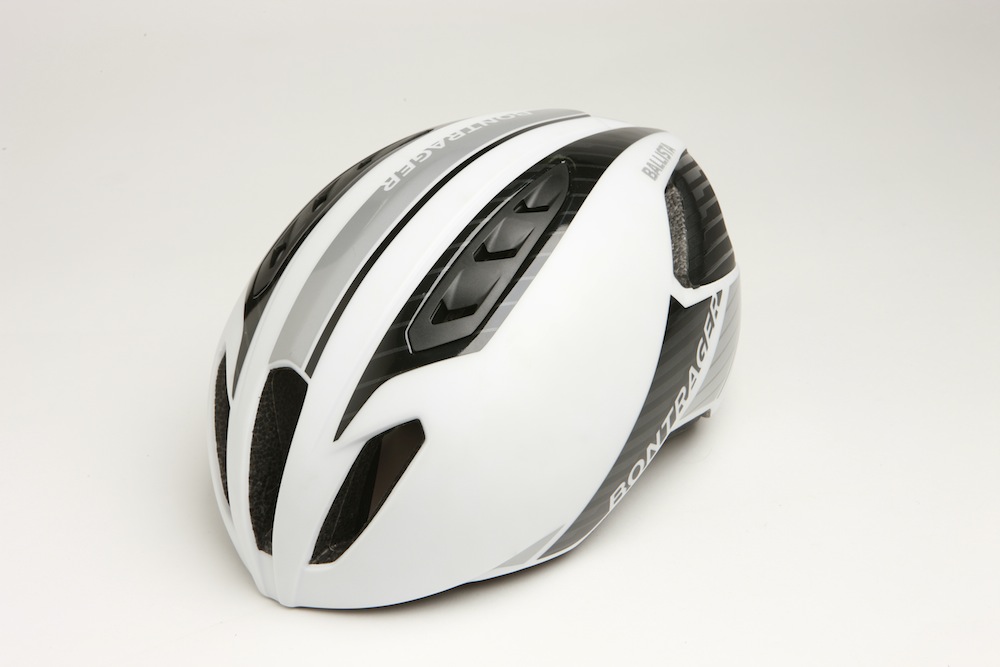
Weight 267g (Medium)
Score, following aero testing: 8/10
Price: £129.99
Read more: Bontrager Ballista helmet review
Aero performance: Second of four for Michelle, third of four for James
One of the most obvious claims to fame for the Ballista is that was the helmet used by Jens Voigt during his successful 2014 Hour Record attempt. It was tested in the wind tunnel, and place side to side with the Specialized Evade, there are certainly similarities in the overall shape.
On test, we adopted it as a go-to racing helmet, finding the breathability to be more than sufficient for hard efforts, even in the summer. The three vents do provide less airflow when compared with standard helmet, but we never found the venting to be insufficient.
One bug bear is that with its 3 large vents, there’s not an obvious sunglass port, which can be annoying if you need to remove your glasses and want to keep them safely stowed.
The internal AgION padding is antimicrobial, meaning the helmet doesn’t get as smelly. The padding is removable too. We found the fit to be comfortable for both riders, too.
Bontrager has added a MIPS layer to this design, in keeping with most of the helmets within the test and ticking a safety box which is becoming more important to meeting consumer expectation.
The Bontrager Ballista scores high marks for value. £129.99 is a lot of money, but for a wind-tunnel designed helmet used by top professionals, it is significantly cheaper than equivalent products from competitor brands. What’s more, the quality is right up there and it’s pretty light too.
Aerodynamically, the Ballista didn’t prove to be the fastest for either tester, but it wasn’t a slouch – indeed riding in the drops in the head-up position, it was fastest for Michelle and took second place of the four, though it was third overall for James and proved to be his worst option when riding in the drops with a low head position.
So, which helmet was the best?
Results per helmet per position
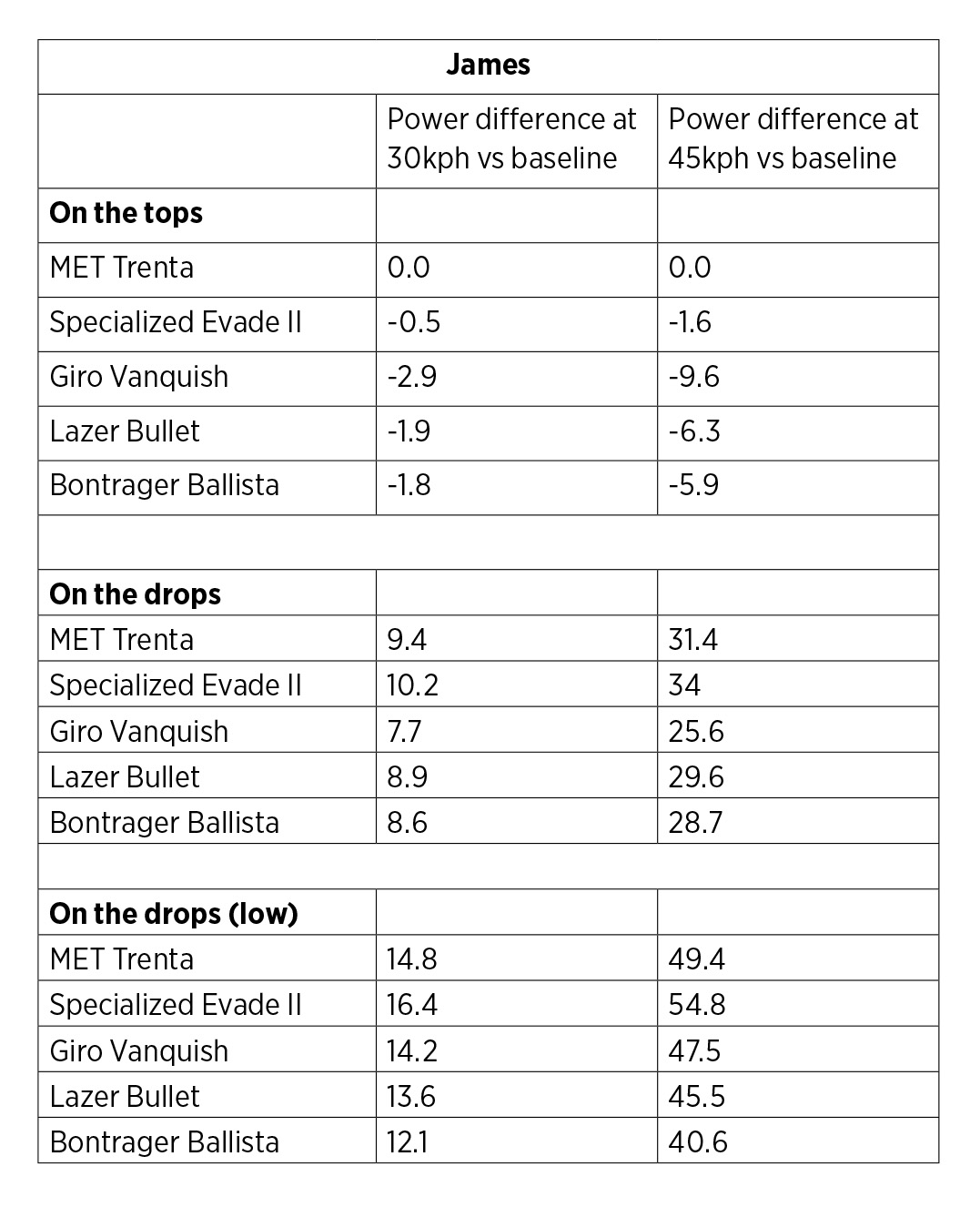

Results per helmet, averaged
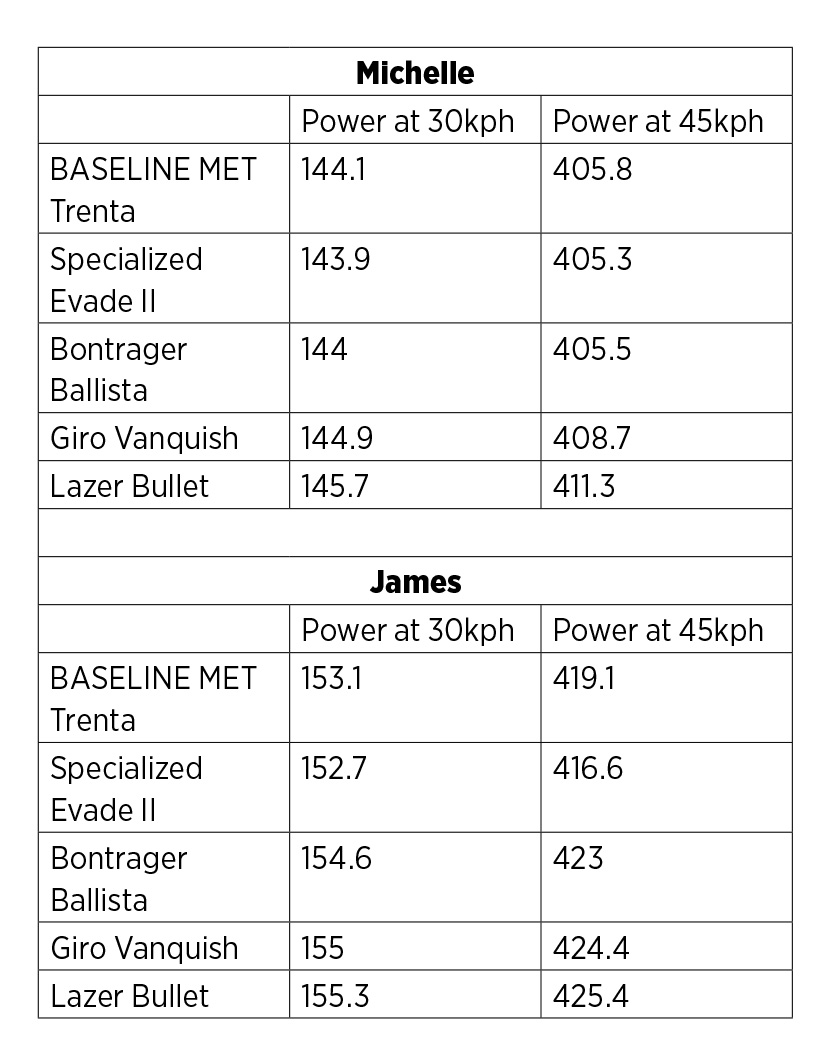
The first thing we noted was that at 30kph, the differences between the best and worst helmets were marginal – in the region of two to three watts. This increased at 45kph to the region of 9 to 10 watts. For many riders, choosing the helmet that’s the most comfortable could be a bigger all-round performance gain.
However, in any numbers game, there’s always going to be winners and losers.
For our smaller tester, Michelle, the Specialized Evade was the fastest on the tops, the Bontrager Ballista was fastest on the drops, and interestingly the Met Trenta was the most efficient when in the drops with a low head position. If we average all of the numbers out, the Specialized Evade performed the best.
The Lazer Bullet was the worst for her, across all tests, with the Giro Vanquish second worst.
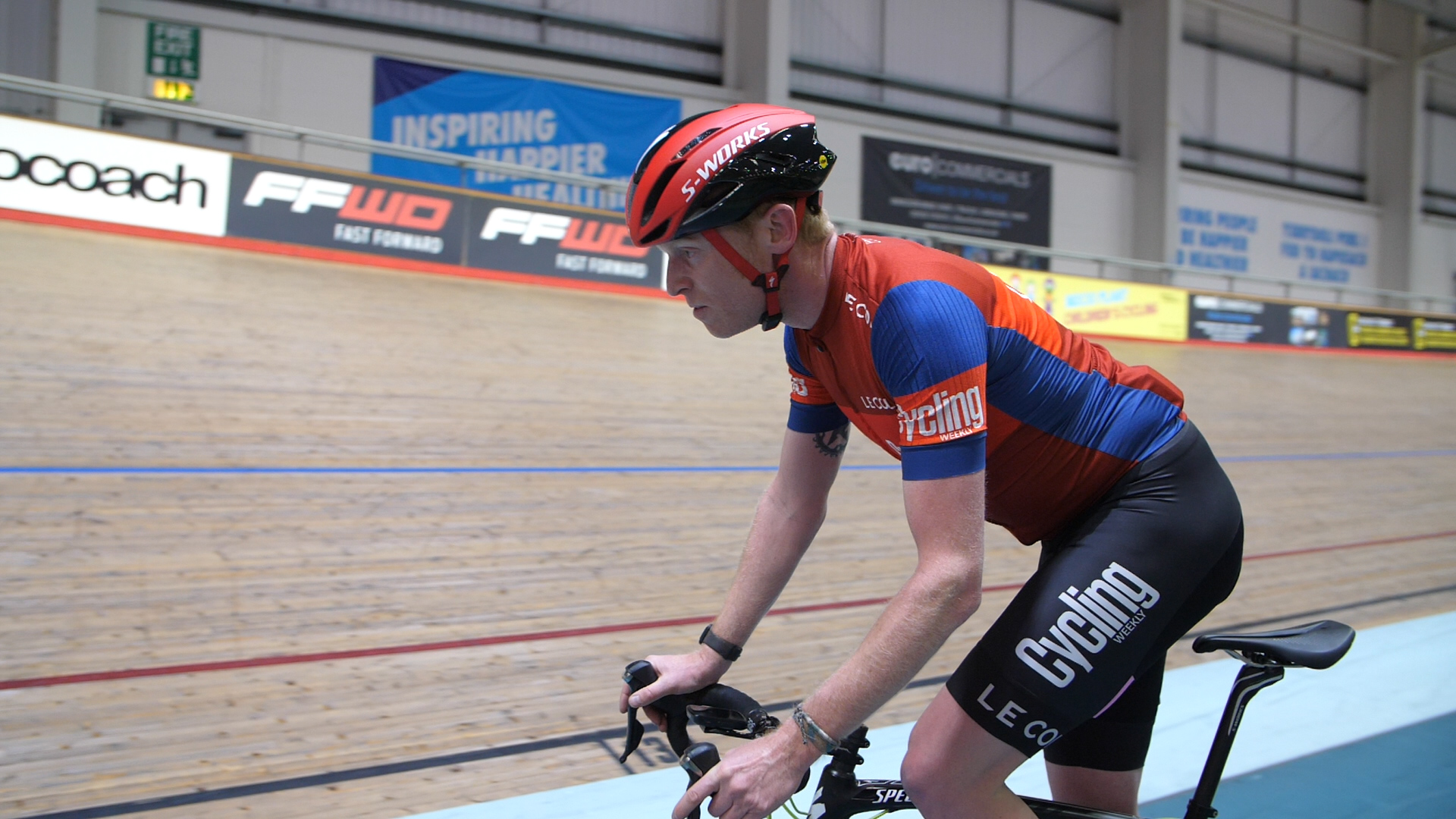
On our taller tester, James, the Met Trenta was very marginally faster when on the tops. However, the Evade was fastest in the drops and in the drops with a lower head – so all round, again the Evade would be the most aerodynamic choice for him.
When we average the results across positions, the Giro Vanquish was the slowest helmet for James.
It’s important to remember that both the Vanquish and Bullet would likely be faster with the visor and aero cover respectively.
A special mention has to go to the Met Trenta (£220) – which held its own, it is an optimised helmet, but it's not the brand’s dedicated aero lid.
Whilst we did test the effectiveness of the different helmets when riders moved their heads around, we found no significant differences between helmets.
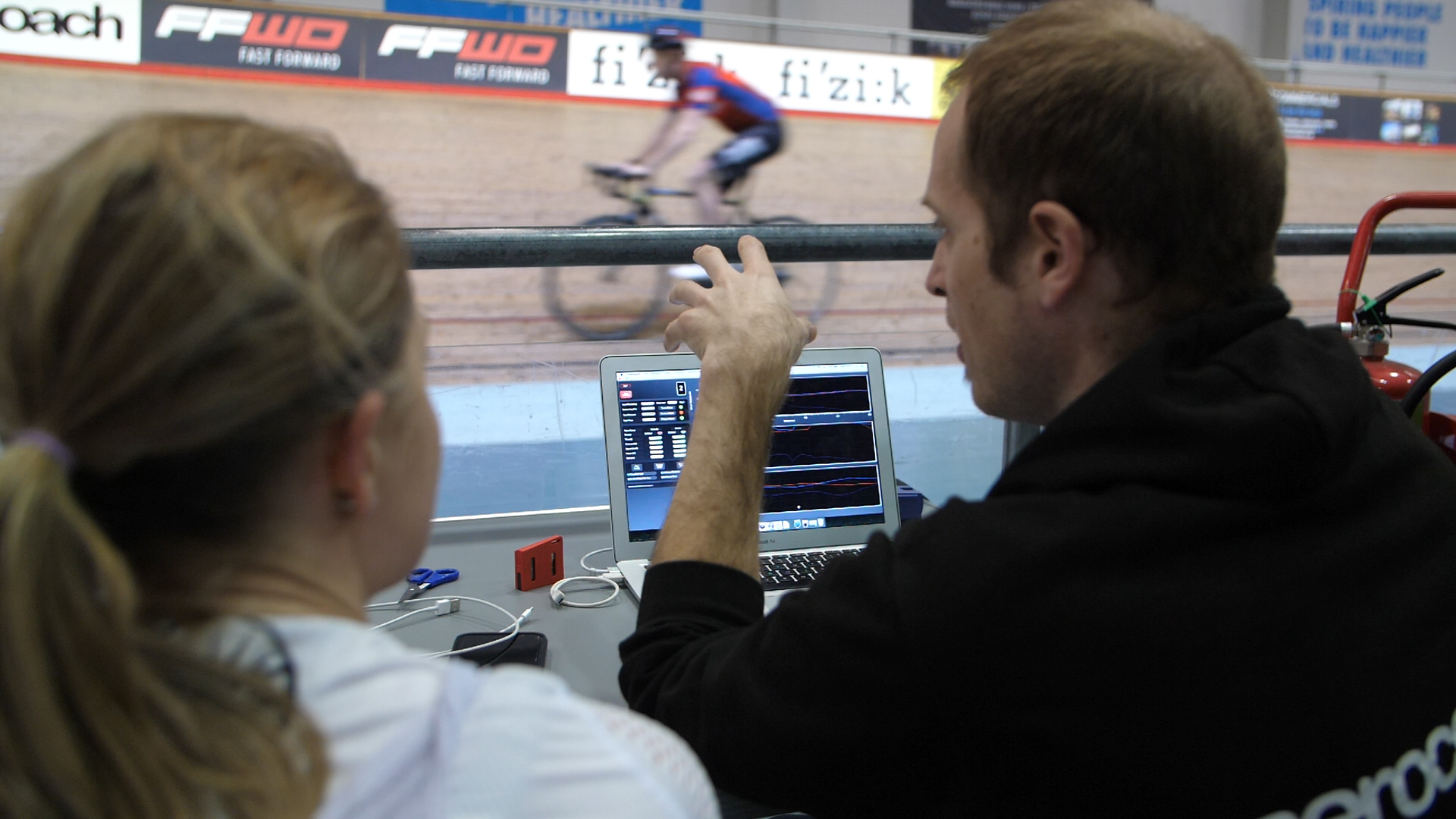
There were differences between individuals, but without the expertise we had available to us, it would be hard for those at home to collect data on the most optimal helmet for them.
Disley’s advice there?
“Reading up on data that’s been published - for example the testing we’ve done here - is a good way of establishing the differences and best performers. The take home message from today was that the Evade is a good helmet, so from this data, that would be the one I’d recommend.”
Michelle Arthurs-Brennan the Editor of Cycling Weekly website. An NCTJ qualified traditional journalist by trade, Michelle began her career working for local newspapers. She's worked within the cycling industry since 2012, and joined the Cycling Weekly team in 2017, having previously been Editor at Total Women's Cycling. Prior to welcoming her first daughter in 2022, Michelle raced on the road, track, and in time trials, and still rides as much as she can - albeit a fair proportion indoors, for now.
Michelle is on maternity leave from April 2025 until spring 2026.
